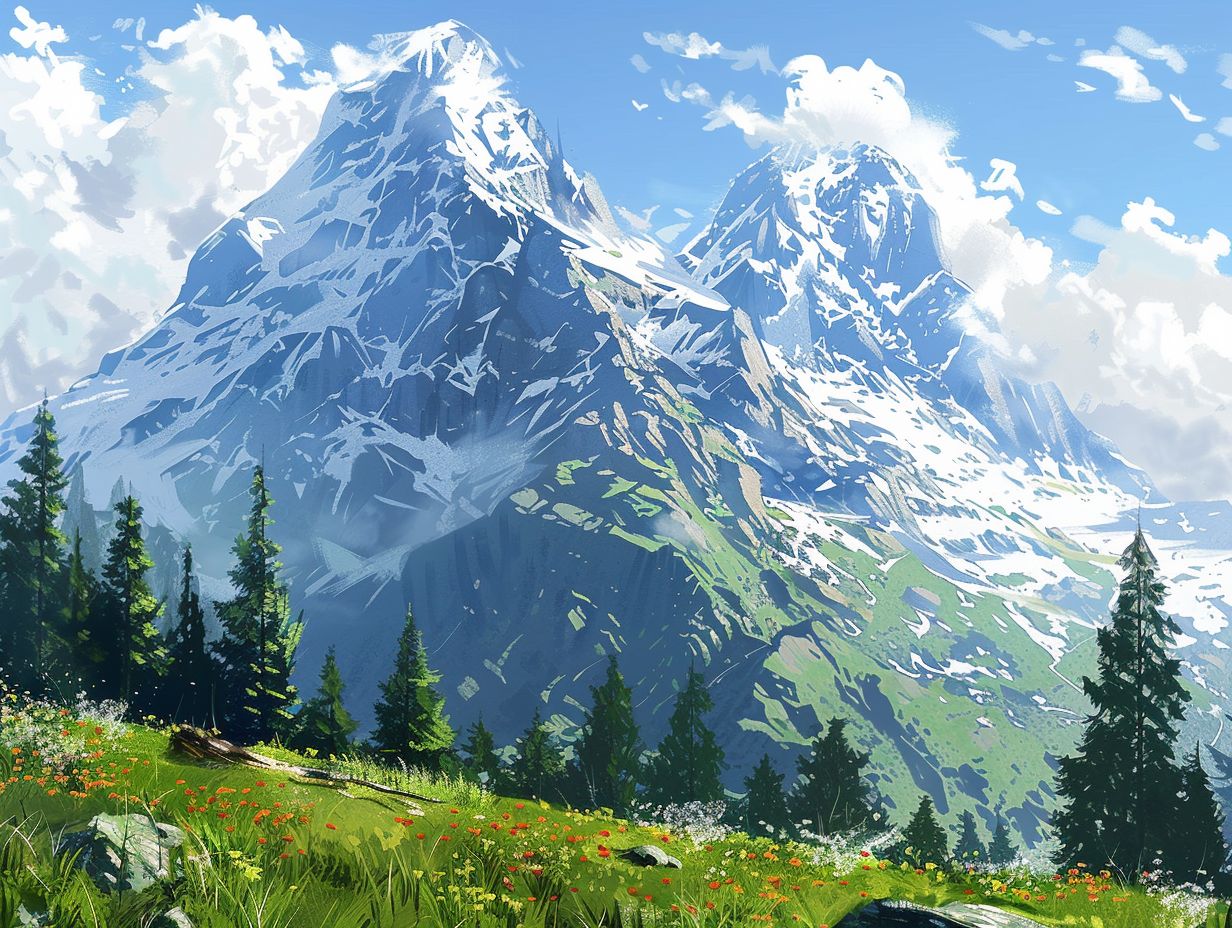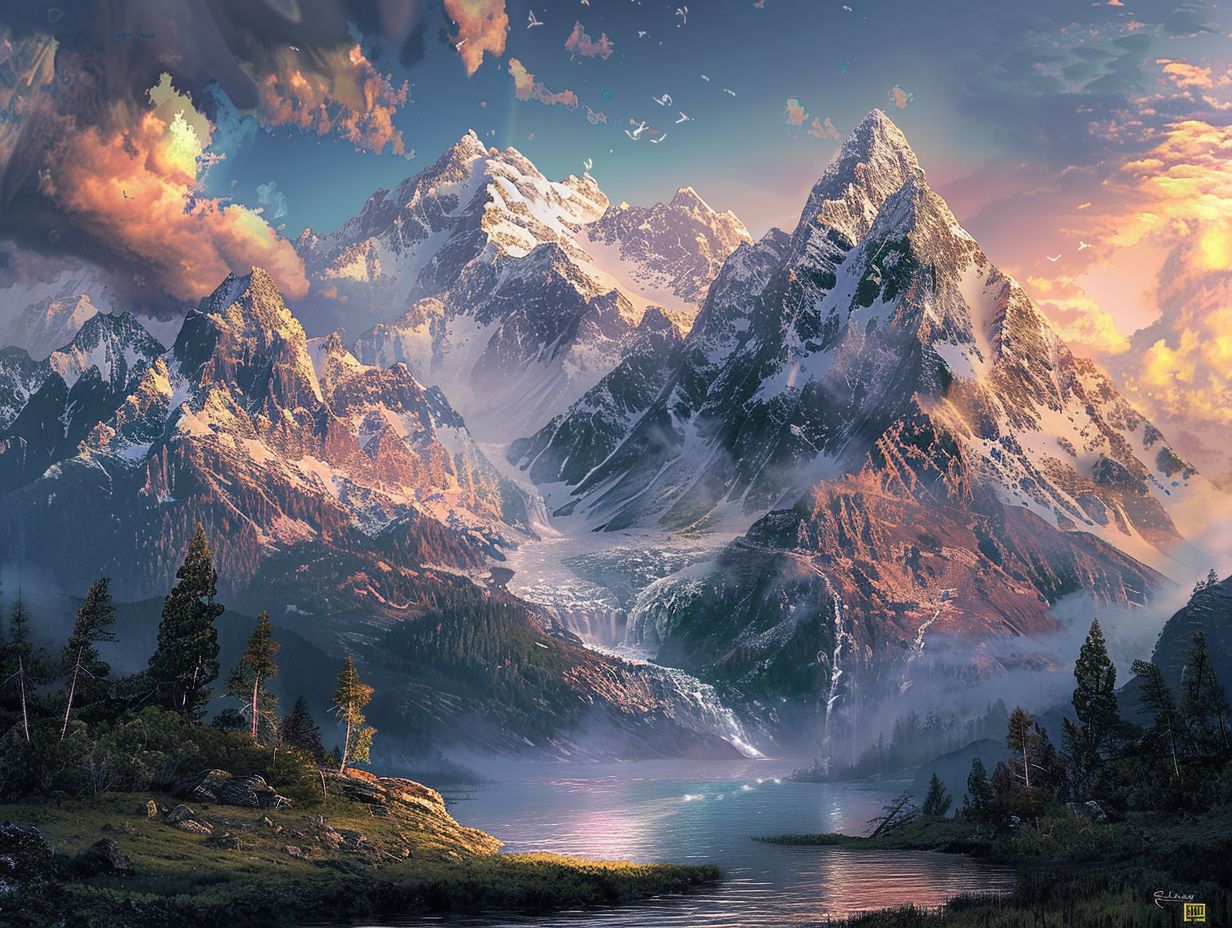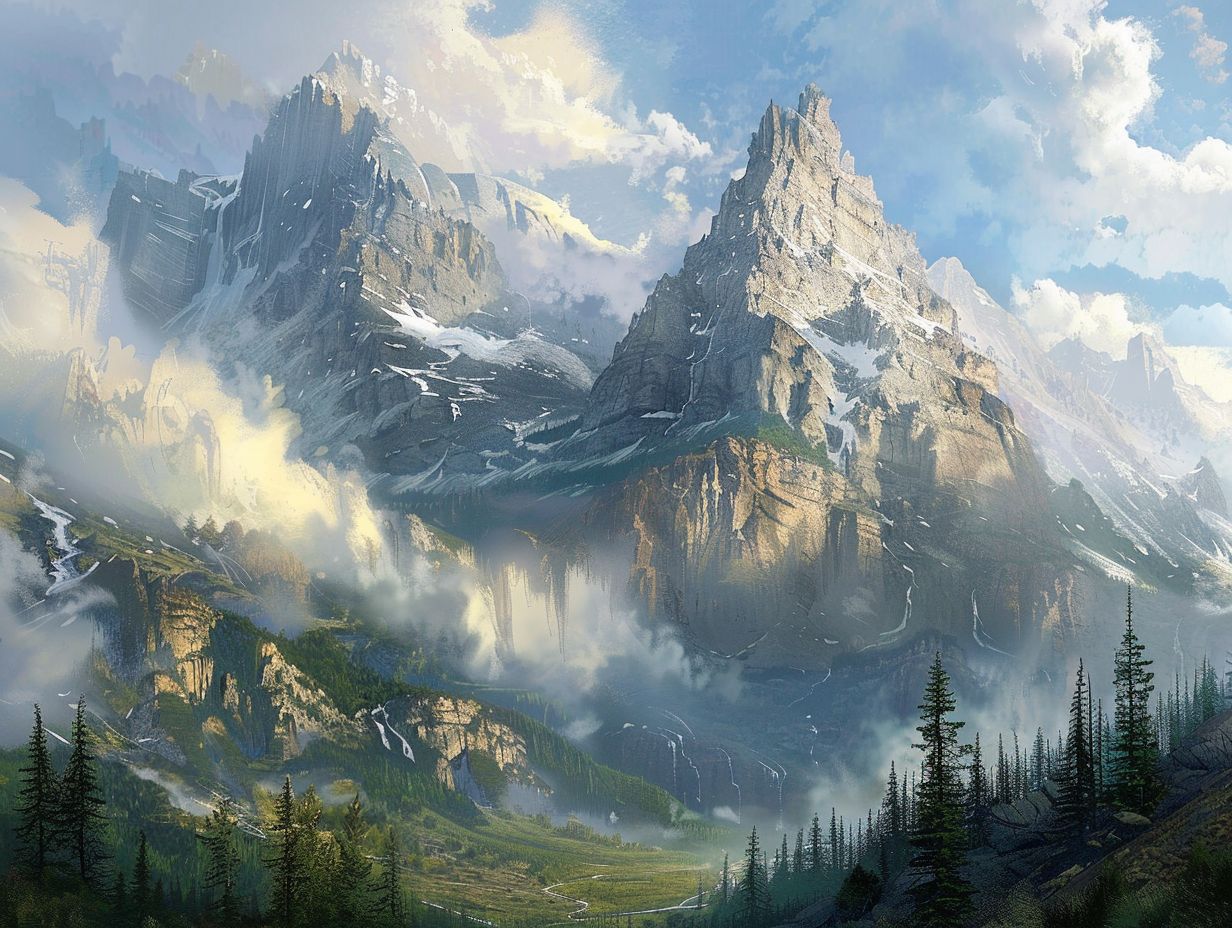
Kilimanjaro Vs K2
Are you a fan of mountain climbing or just curious about the world’s highest peaks?
We compare two of the most iconic mountains on Earth: Kilimanjaro and K2.
From their location and geographic features to the difficulty of climbing and various routes available, we explore the altitude, weather, and climate of these majestic mountains.
Join us as we delve into the stories of famous climbers and notable records associated with both Kilimanjaro and K2.
Key Takeaways:

- Kilimanjaro and K2 are located in different countries, with Kilimanjaro being in Tanzania and K2 in Pakistan.
- While Kilimanjaro has various climbing routes, K2 has only a few, making it a more challenging mountain to climb.
- The altitude of Kilimanjaro is lower than K2, but both mountains pose risks for climbers due to high altitudes and extreme weather conditions.
Location and Geographic Features
Kilimanjaro and K2 are two iconic mountains located in vastly different regions, with Kilimanjaro situated in Tanzania, Africa, and K2 in the Karakoram Range.
These mountains boast distinct geographic features that attract climbers and adventurers from around the world.
Kilimanjaro, known as the highest peak in Africa, is a dormant stratovolcano characterized by its three volcanic cones: Kibo, Mawenzi, and Shira.
On the other hand, K2, often referred to as the Savage Mountain, is renowned for its steep pyramidal peak and notoriously challenging climbing routes.
The majestic Mount Kilimanjaro captivates with its snow-capped summit contrasting against the African savannah, offering a surreal visual experience.
In contrast, the rugged terrain of K2 presents thrilling challenges for even the most experienced mountaineers, with unpredictable weather conditions and technical climbs.
Where is Kilimanjaro Located?
Kilimanjaro is located in Tanzania, a country in East Africa known for its diverse wildlife, stunning landscapes, and rich cultural heritage.
Tanzania, a land of ecological wonders, is home to Kilimanjaro, the highest freestanding mountain in the world.
This majestic peak, standing at approximately 19,340 feet above sea level, is a dormant stratovolcano that attracts adventurers and nature enthusiasts from around the globe.
The awe-inspiring sight of Kilimanjaro’s snow-capped summit glistening under the African sun is truly a sight to behold.
Where is K2 Located?
K2, also known as Mount Godwin-Austen, is located in the Karakoram Range, near Mount Everest, making it one of the most challenging peaks to summit in the world.
Standing tall at an elevation of 8,611 meters (28,251 feet), K2 is the second-highest mountain on Earth, known for its unforgiving terrain and extreme weather conditions.
Situated on the China-Pakistan border, K2 is surrounded by towering peaks and glaciers, offering a visually stunning yet perilous setting for climbers.
Its remote location and rugged terrain pose immense challenges to mountaineers, requiring advanced technical skills and endurance to navigate the treacherous slopes.
The geological complexities of K2’s region contribute to the high level of difficulty faced by those attempting to conquer this formidable peak.
What are the Geographic Features of Kilimanjaro?
Kilimanjaro’s geographic features include lush rainforests at its base, followed by alpine meadows and finally snow-capped glaciers near the summit.
As climbers ascend Kilimanjaro, they experience drastic changes in vegetation and climate due to its unique geographical setup.
The rainforests teem with life, showcasing a myriad of plant and animal species adapted to the humid conditions.
Moving higher, the alpine meadows offer a welcome respite with their picturesque open spaces and colorful wildflowers dotting the landscape.
Reaching the snow-capped glaciers at the peak presents a surreal contrast to the warmth of the lower slopes.
The challenges of navigating through the rugged terrain are matched only by the awe-inspiring beauty that surrounds climbers in every direction.
What are the Geographic Features of K2?
K2 is characterized by steep rocky slopes, massive glaciers, and unpredictable weather conditions, earning it the reputation of being one of the most dangerous mountains.
Nicknamed the ‘Savage Mountain’, K2’s treacherous terrain presents climbers with a formidable challenge, with steep faces and technical sections.
The climbing routes on K2, such as the infamous Abruzzi Spur and Cesen Route, are known for their difficulty and inherent dangers, including rock falls and avalanches.
The extreme altitudes on K2, reaching over 8,000 meters, result in thin air that tests climbers’ physical endurance and mental resilience.
Harsh weather conditions, including fierce winds and sudden storms, add to the mountain’s deadly allure, making any ascent a daring and risky endeavor.
Difficulty and Climbing Routes
Both Kilimanjaro and K2 present significant challenges to climbers due to their high altitude, technical routes, and unpredictable weather conditions.
While Kilimanjaro is known for being a non-technical ascent, reaching the summit still requires physical endurance and mental determination.
On the other hand, K2, the world’s second-highest peak, demands advanced climbing skills and experience due to its steep terrain, crevasses, and challenging weather patterns.
The dangers on K2 are further emphasized by its nickname ‘The Savage Mountain.’
Which Mountain is Harder to Climb?

Comparing the climbing challenges of Kilimanjaro and K2, K2 is widely considered to be more difficult and dangerous due to its technical climbing routes, extreme altitude, and harsh weather conditions.
Regarding mountain climbing, it’s not just about reaching the summit but navigating the arduous journey to get there.
K2’s steep slopes, sheer rock faces, and unpredictable weather make it a true test of mountaineering skills.
Climbers attempting K2 face the constant threat of avalanches, crevasses, and high winds, adding to the complexity and risk of the ascent.
The extreme altitude of K2 poses significant challenges, with climbers having to contend with altitude sickness, lack of oxygen, and the physical toll of pushing their bodies.
The technical climbing routes on K2 demand advanced climbing techniques, including ice climbing, rock climbing, and navigating through treacherous terrain.
What are the Different Climbing Routes for Kilimanjaro?
Kilimanjaro offers several climbing routes, including the popular Marangu route and the challenging Machame route, each providing climbers with unique experiences and terrain to conquer.
The Marangu route, also known as the “Coca-Cola route,” is favored for its relative ease due to its gradual slopes and hut accommodations.
The Machame route, dubbed the “Whiskey route,” presents a more demanding ascent through varying landscapes, including lush rainforests, rocky ridges, and alpine deserts.
The Lemosho route, considered one of the most scenic routes, offers panoramic views and diverse wildlife sightings, making it a favorite among nature enthusiasts.
On the Rongai route, climbers can enjoy a quieter experience approaching Kilimanjaro from the north, with the high probability of spotting antelopes.
What are the Different Climbing Routes for K2?
K2 offers challenging climbing routes such as the Abruzzi Spur and the Cesen route, which demand advanced mountaineering skills, technical expertise, and endurance.
The Abruzzi Spur, also known as the Southeast Ridge, is one of the most popular and frequently attempted routes on K2.
This route requires climbers to navigate a series of technical challenges, including steep rock faces and exposed sections.
One of the unique features of the Abruzzi Spur is the House’s Chimney, a narrow gully that poses a significant obstacle for climbers.
On the other hand, the Cesen route, located on the southwest face of the mountain, is characterized by its steep slopes and mixed terrain.
Altitude and Elevation
Altitude is pivotal in the climbing experiences of Kilimanjaro (5,895 meters) and K2 (8,611 meters), posing significant challenges for climbers.
The difference in altitude between these two majestic peaks directly impacts the difficulty level of ascents, influencing various factors like oxygen levels and climatic conditions.
Climbers attempting Kilimanjaro, though lower in elevation compared to K2, still face the risks associated with high altitudes, including altitude sickness and decreased oxygen saturation levels.
Acclimatization becomes imperative as climbers ascend to higher altitudes, allowing their bodies to adjust gradually to the reduced oxygen availability.
This process aids in preventing altitude-related illnesses and ensures a safer journey to the summit.
What is the Altitude of Kilimanjaro?
Kilimanjaro, standing at approximately 5,895 meters above sea level, presents climbers with altitude-related challenges as they ascend towards the iconic Uhuru Peak.
At such high altitudes, the lack of oxygen puts significant strain on the body, leading to symptoms of altitude sickness like headaches, nausea, and fatigue.
To combat these effects, climbers must acclimate gradually by spending additional time at intermediate camps to allow their bodies to adjust to the reduced oxygen levels.
Proper hydration and nutrition are crucial during the ascent to maintain energy levels.
Reaching the summit of Kilimanjaro is not just a physical achievement but also a spiritual and emotional triumph for many climbers.
The breathtaking views from Uhuru Peak and the sense of accomplishment that comes with conquering Africa’s highest point make the arduous journey worthwhile.
What is the Altitude of K2?
K2, stands as the second-highest mountain in the world, challenging climbers with extreme altitudes, harsh weather, and technical climbing requirements.
Climbing in the ‘death zone,’ above 8,000 meters, presents a myriad of challenges due to the thin air, low oxygen levels, and increased risk of altitude sickness.
Achieving success on K2 demands profound physical fitness, mental endurance, and expert mountaineering skills.
Mountaineers face the daunting task of acclimatizing to the high altitude gradually to reduce the risks of pulmonary or cerebral edema.
The extreme elevation combined with unpredictable weather conditions makes K2 one of the most dangerous and formidable peaks to summit.
How Does Altitude Affect Climbing?
Altitude exerts a significant impact on climbers attempting both Kilimanjaro and K2, affecting oxygen levels, physical performance, and overall well-being.
At high altitudes, oxygen becomes sparse, making it harder for climbers to breathe and sustain physical exertion.
Insufficient oxygen supply can lead to altitude sickness, manifesting as headaches, nausea, fatigue, and difficulty sleeping.
To combat these effects, climbers need to acclimatize gradually by ascending slowly, staying hydrated, and consuming a diet rich in carbohydrates and electrolytes.
Physiological adaptations like increased red blood cell production and improved lung efficiency are crucial for successful ascents.
Weather and Climate

Weather is crucial in climbing experiences on Kilimanjaro and K2. Kilimanjaro boasts diverse climate zones, from rainforests to glaciers, while K2 faces severe storms and unpredictable weather.
These varying conditions present unique challenges for climbers, as they navigate through different ecosystems and weather phenomena.
Altitude also plays a significant factor on both mountains, with climbers facing altitude sickness and decreased oxygen levels as they ascend.
On Kilimanjaro, the shifting weather conditions in each climate zone require climbers to be prepared for sudden changes in temperature and precipitation.
Meanwhile, K2’s reputation for harsh weather means climbers must be equipped to handle extreme cold, high winds, and whiteout conditions.
What is the Weather like on Kilimanjaro?
Kilimanjaro offers a climatic adventure, with tropical rainforests at lower elevations shifting to freezing temperatures and snowfall higher up, reflecting its diverse climate zones.
As climbers ascend Kilimanjaro, they encounter distinct climate transitions, starting from the lush greenery of the rainforests, known for their high humidity and frequent rainfall.
Moving further up, the landscape shifts into the heath zone with scrubby vegetation and cooler temperatures.
Climbers transition from the alpine desert’s rocky terrain to the arctic zone above 16,000 feet, where snow and ice dominate the landscape.
Seasonal variations play a crucial role in the weather patterns of Kilimanjaro.
The dry seasons, typically from June to October and January to March, offer clearer skies and better climbing conditions.
In contrast, the wet seasons of April to May and November to December bring heavy rainfall, colder temperatures, and increased risk of slippery trails and reduced visibility.
What is the Weather like on K2?
K2 is notorious for its harsh weather conditions, characterized by extreme cold, fierce winds, and unpredictable storms that can strike at any moment.
Climbers on K2 often face temperatures that plummet well below freezing, turning the ascent into a battle against the elements.
The high altitude amplifies the effects of the cold, making it even more challenging to stay warm and avoid frostbite.
The ferocious winds on the mountain can reach speeds that threaten to knock climbers off their precarious paths, adding a constant struggles.
How Does Climate Affect Climbing?
The climate on Kilimanjaro and K2 significantly impacts climbing expeditions, influencing route conditions, gear requirements, and safety considerationss.
When embarking on a climb up Kilimanjaro or K2, climbers must meticulously plan their journey to adapt to the ever-changing weather patterns.
Weather forecasting becomes a crucial tool in determining the optimal time to ascend, as sudden shifts in climate can pose serious risks to climbers.
The selection of appropriate clothing and equipment plays a pivotal role in mitigating these risks, with sturdy footwear, insulated layers, and high-altitude gear.
Understanding how weather conditions differ along the ascent routes is imperative for devising a successful climb strategy.
Climbers must account for the variability in temperatures, wind speeds, and precipitation levels at different altitudes, ensuring they are adequately equipped.
Famous Climbers and Records
Kilimanjaro and K2 have attracted renowned climbers and adventurers, with notable figures such as Sir Edmund Hillary and Reinhold Messner.
Both Hillary and Messner left an indelible mark on the mountaineering world with their unparalleled achievements.
Sir Edmund Hillary, the first individual confirmed to reach the summit of Mount Everest, also conquered Kilimanjaro in his illustrious career.
On the other hand, Reinhold Messner, known for his solo ascent of Mount Everest without supplemental oxygen, showcased his expertise on K2.
The successful ascents of these legendary climbers not only solidified their places in mountaineering history but also inspired generations.
Who are Some Famous Climbers of Kilimanjaro?
Renowned climbers like Hans Meyer and Charlie Waughray are among the notable individuals who have conquered the summit of Kilimanjaro.
Apart from Hans Meyer and Charlie Waughray, other legendary mountaineers such as Reinhold Messner and Ed Viesturs have also left their mark.
Their ascents on this majestic peak have not only set records but have also significantly contributed to the world of mountaineering, inspiring countless adventurers worldwide.
The challenges faced by these climbers were monumental, from extreme weather conditions to altitude sickness.
Nevertheless, through meticulous planning, physical endurance, and mental fortitude, they conquered the 19,340 feet high peak.
Who are Some Famous Climbers of K2?
Legendary mountaineers such as Reinhold Messner and Gerlinde Kaltenbrunner have left their mark on K2, achieving remarkable feats and setting records.
Reinhold Messner, known for his solo ascent of K2 without supplemental oxygen in 1979, is revered for revolutionizing alpine style climbing.
His daring approach and relentless spirit set a new standard in mountaineering.
On the other hand, Gerlinde Kaltenbrunner, who became the first woman to conquer all 14 eight-thousanders without artificial oxygen.
These climbers not only conquered the peak but also inspired generations with their courage and tenacity.
What are Some Notable Records for Climbing Kilimanjaro?

Several notable records have been set on Kilimanjaro, including the fastest ascent, youngest climber to reach the summit, and most consecutive summits.
Kilimanjaro, with its towering peaks and challenging terrain, has witnessed numerous remarkable feats by adventurers from around the world.
The record for the fastest ascent, achieved by a seasoned mountaineer, stands as a testament to human endurance and determination.
Likewise, the youngest climber to conquer Kilimanjaro’s summit showcased unparalleled courage and resilience.
The triumph of those who achieved multiple consecutive summits within a limited timeframe reflects the unwavering spirit of exploration.
What are Some Notable Records for Climbing K2?
K2’s history is marked by exceptional records, including the first successful winter ascent, fastest climb, and most summits by individual climbers.
These remarkable feats on K2 serve as a testament to human resilience and the pursuit of greatness in the face of extreme adversity.
The historic achievements on this majestic peak stand as a beacon for aspiring mountaineers worldwide, beckoning them to push the boundaries of exploration and endurance.
The enduring legacy of mountaineering excellence carved into the icy facade of K2 continues to inspire awe and respect, honoring those who dared to challenge the limits.
Frequently Asked Questions
1. What is the difference between Kilimanjaro and K2?
A: Kilimanjaro and K2 are two of the most famous mountains in the world, but they have many differences. Kilimanjaro is located in Tanzania, while K2 is located in Pakistan. Additionally, Kilimanjaro is a dormant volcano, while K2 is the second highest mountain in the world and is known for its treacherous climbing conditions.
2. Which is taller, Kilimanjaro or K2?
A: K2 is taller than Kilimanjaro, with a height of 8,611 meters compared to Kilimanjaro’s 5,895 meters. This makes K2 the second highest mountain in the world, while Kilimanjaro is the highest mountain in Africa.
3. Which is more difficult to climb, Kilimanjaro or K2?
A: While both mountains are challenging to climb, K2 is considered to be much more difficult than Kilimanjaro. K2 has a much steeper and more technical route, with a higher risk of avalanches and rock falls. Kilimanjaro, on the other hand, is a non-technical climb with only a few basic rock scrambles.
4. How long does it take to climb Kilimanjaro vs K2?
A: The average time to climb Kilimanjaro is 7-9 days, while the average time to climb K2 is 60 days. This is due to the longer and more difficult route on K2, as well as the need for acclimatization at high altitudes.
5. Can I climb Kilimanjaro and K2 in the same trip?
A: While it is physically possible to climb both Kilimanjaro and K2 in the same trip, it is not recommended. These two mountains are located on different continents and require very different levels of skill and experience. It is best to plan separate trips for each mountain.
6. Which mountain is more popular, Kilimanjaro or K2?
A: Kilimanjaro is considered to be the more popular mountain, with over 30,000 people attempting to climb it each year. K2, on the other hand, sees less than 500 attempts per year due to its challenging conditions and limited climbing season.